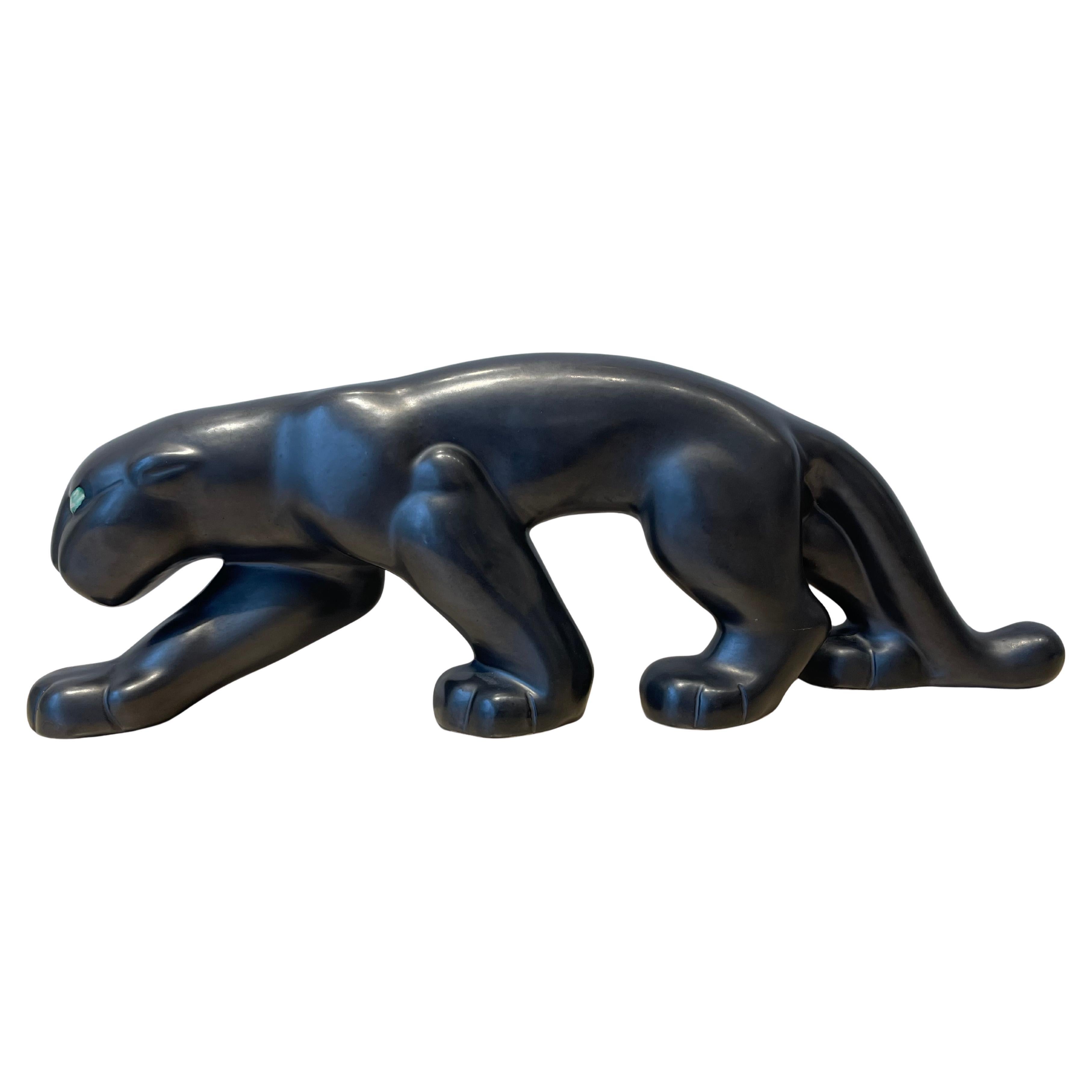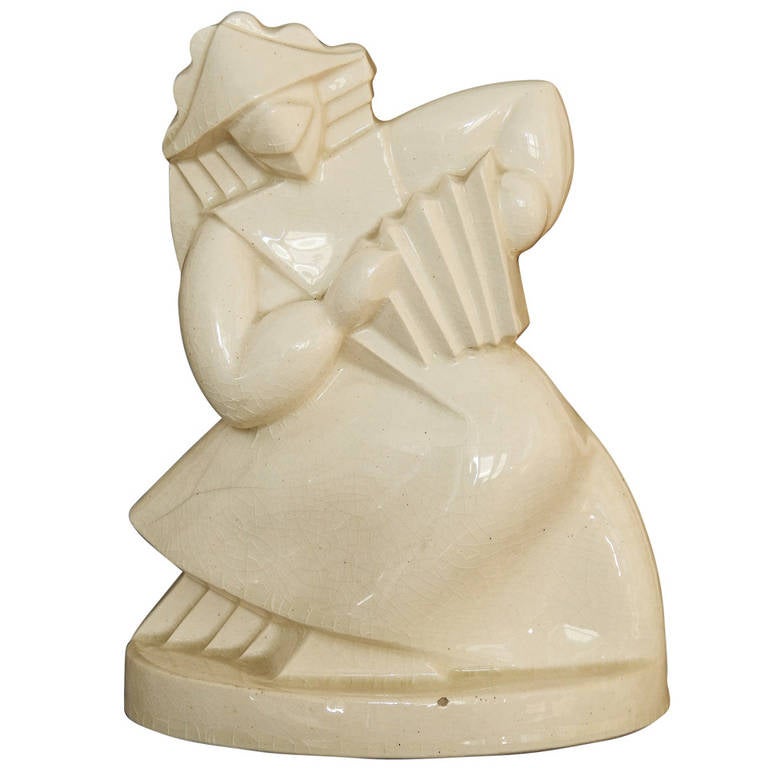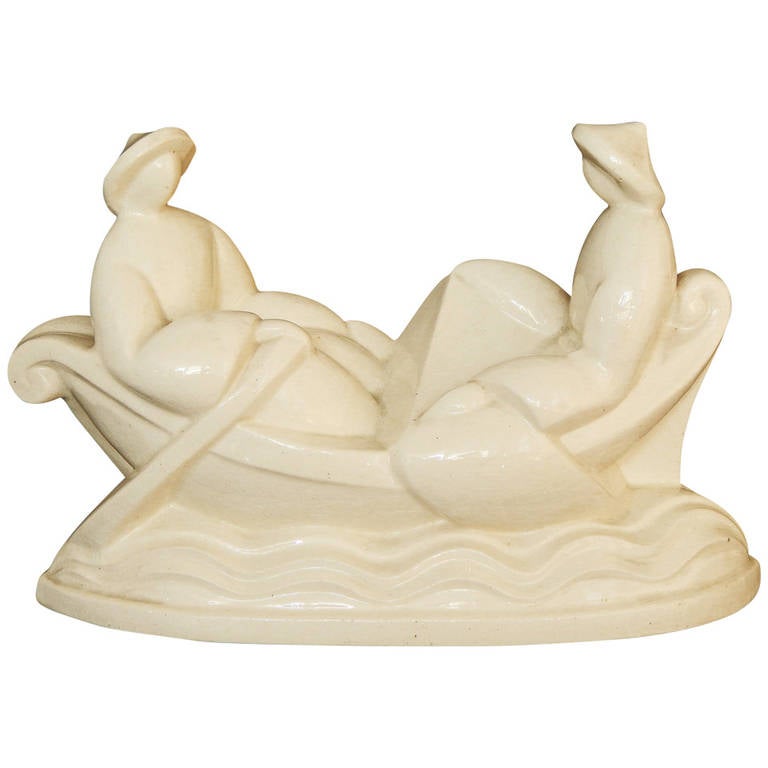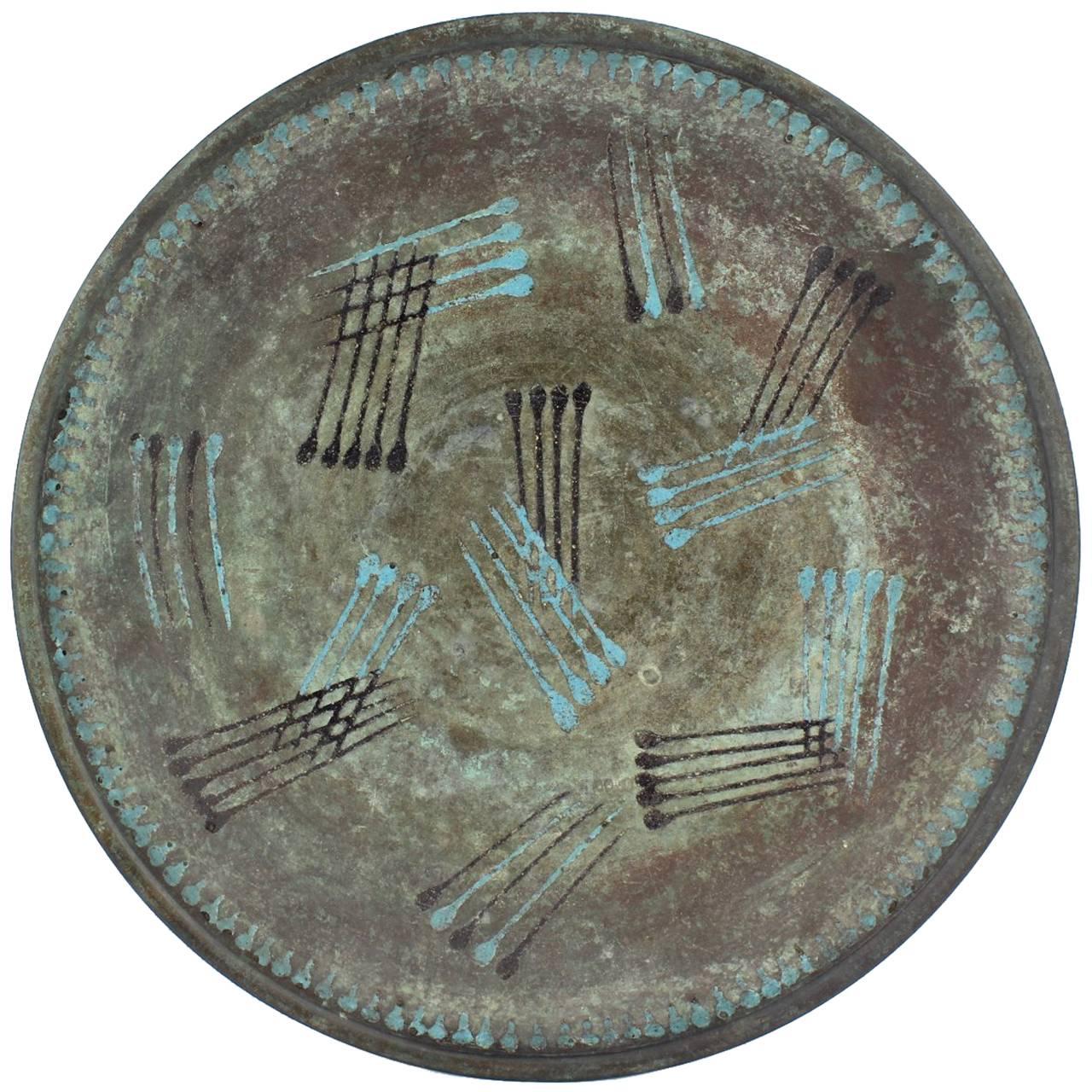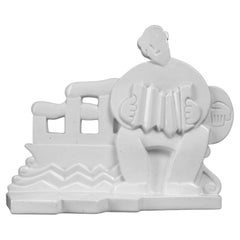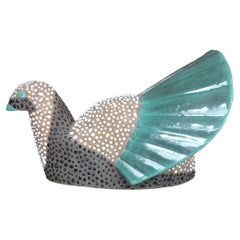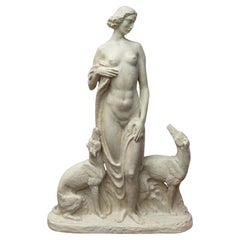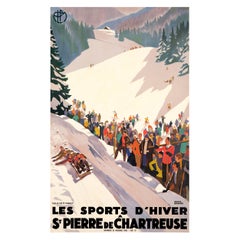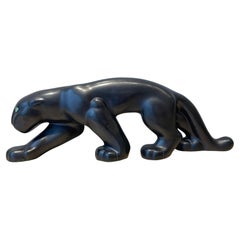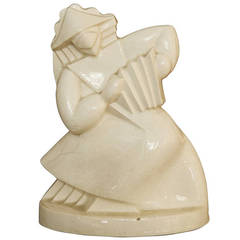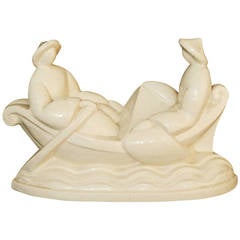Items Similar to PRIMAVERA / CLAUDE LEVY (attribution). Art Deco Dove. Crackled White Earthenware
Want more images or videos?
Request additional images or videos from the seller
1 of 10
PRIMAVERA / CLAUDE LEVY (attribution). Art Deco Dove. Crackled White Earthenware
About the Item
PRIMAVERA (1926) - Claude Levy (attribution) / Edouard Chassaing sculptor.
Large pigeon posed in profile in crackled white earthenware slightly cracked.
Factory of Sainte-Radegonde.
Perfect condition despite a tiny chip on the terrace.
Documentation: exhibited at the Salon d'Automne, 1926; Renaissance of French Arts, 1928. Primavera,
Documentation:
. Exhibition Salon d'Automne, 1926 (Guillemard stand);
. Renaissance des Arts français, Nov. 1928;
Emblem of the 3rd PFADM (Small Modern Decorative Arts Fair of Le Printemps), 1929.
.Photo: bronze edition by Chassaing
PRIMAVERA L'ATELIER D'ART DU PRINTEMPS
In September 1912, the department store Le Printemps created a structure for the production of furniture and modern art objects, called Atelier Primavera.
This unprecedented initiative, taken by René Guilleré, founder of the Société des Artistes décorateurs and Pierre Laguionie, young manager of Le Printemps, who proposes to provide the Parisian store with a structure for the production of furniture and modern works of art, constitutes a crucial moment in the evolution of design in the 20th century.
The decoration and all its components, furniture, rugs, lighting, upholstery, table services, and above all, art glassware and ceramic trinkets, staged with pomp during the Decorative Arts Exhibition of 1925, thus making innovation and modernity in the field of decorative arts accessible to all through a powerful commercial tool.
The updating of forms under the influence of cubism will be implemented there by talented creators such as Claude Lévy and Madeleine Sougez, lovers of contemporary themes such as sports, jazz, the Ballets Russes and, thanks to the modernist spirit of Louis Sognot and the timely intervention of Jacques Viénot, founder of industrial aesthetics, the way could open towards the democratization of furniture consumption.
Very affected by the crisis of the 1930s and devastated by the war, Primavera will owe an unexpected rebirth to its director, Colette Gueden, who joined the Atelier in 1927 at the age of twenty-two, who, with courage, intelligence and flair will make it, during the 50s and 60s, thanks to its animations full of inventiveness and fantasy, one of the trendiest places in the capital, where one last time creation will succeed in asserting its primacy over commerce. .
Bibliography/ Primavera, l’Atelier d’Art du Printemps 1912-1972, Alain-René Hardy, Gerard Tatin, Faton / Vingtième Plus Edition, 2014
LES ARTISTE DE PRIMAVERA : CLAUDE LEVY (1895-1942)
Trained at the School of Decorative Arts, was passionate about her profession, which she enriched with her insatiable curiosity and her appetite for innovation: "Only one thing interests me: the unknown, and I have only one joy: to work. I bring in my work as much novelty as possible." she will declare on the occasion of her Blumenthal prize.
After her arrival at Primavera, she had to apply her know-how, both to the creation of fabrics, lacquered patterns on furniture, and to small objects made in Sainte Radegonde, ashtrays, plates, tobacco jars and vases. earthenware with painted figured decoration (The Golden Age, Joyeuse Ronde, Le Paradis Terrestre), often black on a white background, but also polychrome, and sold for several years from the Salon d'Automne of 1921. Then it was entrusted with the responsibility of rapidly supplying an offer of earthenware subjects with a cracked glaze.
Her enthusiasm for the total spectacle of the Ballets Russes (music, dance, comedy, scenery) which she frequented assiduously made her want to make it her theme for the creation of crackle figurines. Designed in 1922, they were submitted from the fall and throughout 1923 to the appreciation of the refined public of the Decorative Arts Salons. Inspired by different ballets such as Carnaval, Parade, Pulcinella or La boutique fantasque, its seductive crackles, often enhanced with black lines (Woman in a good mood) or discreet colors, apple green and platinum (Pulcinella), even with a frank polychromy (Chinese Conjurer of Parade), also achieved success in the Printemps catalogs which lasted for several years, practically until the dissolution of Diaghilev's company.
This could only encourage C. Lévy to persist in the creation of these modern trinkets and, in addition to subjects such as musicians (Banjo player, Guitarist of the S.A.D. of 1925), clowns, dancers, she later undertook to give life to a whole menagerie (elephant, group of three bears, Grand Duke, charging bull, wild boar, many deer) profusely exhibited at the Grand Palais in 1925, – which earned it a place in the list of awards at the Exhibition with a gold medal, then shown again the following year at the Salon des Décorateurs.
Claude Lévy subsequently became the crackle specialist at the Atelier, drawing dozens and dozens of models that she created, with the help of Edouard Chassaing, in series, making her the most prolific crackle pattern maker in his time, far ahead of the Adnet brothers and Charles Lemanceau. The house factory of Sainte Radegonde owes him even more, to whom it provides illustrations on the theme of work in the fields, among other things, to decorate enamelled sandstone vases, such as, for example, the flat gourd with harvesters and the large vase with hunters. Like many of her colleagues, she also sent some sketches to Paule Petitjean who brought them to life in the ground. Her animal inspiration will also benefit the potters of Soufflenheim, for whom she sketched many "clown" animals made of glazed clay.
Towards the end of his collaboration with Primavera, Claude Lévy, perhaps following a trip there, also proposed original shapes and decorations to the Céramique d'art de Bordeaux; it is plausible that most of the polylobed vases covered with flamed green enamel produced by this workshop are his invention. She also experimented a lot with mixtures of blue, white and gold enamels, arranged in spirals, in parallel lines or informal decorations of seedlings of pellets, lattices or parallel lines of white and black enamel applied on raw clay with a patina but she found it difficult to take the step of pure geometry. Promoted to workshop manager to replace Madeleine Sougez in 1928, the year in which she was honored with the enviable Blumenthal Prize, Claude Lévy also left Printemps at the end of the following year, not without having tried her hand at her ultimate appearance within the Atelier to paintings on glass and mirror produced, in all likelihood, in unique pieces (Salon d'Automne 1928).
From now on, she will stop creating for ceramics, which constitutes the essential of her work as a model maker, – a brilliant and abundant work, giving herself fully to her project of establishing herself as an independent decorator, in the movement of the U.A.M. But, she will end up favoring painting more and more, to which she devoted herself entirely during the last years of her too short life.
LES ARTISTE DE PRIMAVERA : EDOUARD CHASSAING (1895-1974)
A highly appreciated sculptor, exhibiting his works at numerous Salons on a personal basis, but also sometimes under the aegis of Primavera (notably at the Salons d'Automne of 1922, 23 and 24), widely quoted by Guilleré, Edouard Chassaing remained independent as the evidence of the bas-reliefs reproduced by Henri Rapin (Modern decorative sculpture, Ch. Moreau, 1st series, v. 1924, pl. 6) and his various participations in the 1925 Exhibition (Luneville pottery, monumental bas-reliefs for the Christofle pavilion).
He also donated a few models of crackles to La Maîtrise, which competed with Galeries Lafayette, after ending his collaboration with Primavera (end of 1926).
He went into exile in the United States in 1927, in Chicago where he pursued his career as a sculptor and became councilor of the municipality for urban sculpture and professor at the Art Institute.
We have been dealing in art, antiques, lighting, and vintage posters for more than 50 years.
Upon request, we are very happy to provide you with Certificate of Authenticity.
- Attributed to:Atelier Primavera au Printemps (Artist)
- Dimensions:Height: 16.15 in (41 cm)Width: 5.91 in (15 cm)Depth: 11.82 in (30 cm)
- Style:Art Deco (Of the Period)
- Materials and Techniques:
- Place of Origin:
- Period:
- Date of Manufacture:1926
- Condition:Minor losses.
- Seller Location:SAINT-OUEN-SUR-SEINE, FR
- Reference Number:1stDibs: LU7066231663122
About the Seller
5.0
Vetted Professional Seller
Every seller passes strict standards for authenticity and reliability
1stDibs seller since 2022
38 sales on 1stDibs
Typical response time: <1 hour
- ShippingRetrieving quote...Shipping from: SAINT-OUEN-SUR-SEINE, France
- Return Policy
Authenticity Guarantee
In the unlikely event there’s an issue with an item’s authenticity, contact us within 1 year for a full refund. DetailsMoney-Back Guarantee
If your item is not as described, is damaged in transit, or does not arrive, contact us within 7 days for a full refund. Details24-Hour Cancellation
You have a 24-hour grace period in which to reconsider your purchase, with no questions asked.Vetted Professional Sellers
Our world-class sellers must adhere to strict standards for service and quality, maintaining the integrity of our listings.Price-Match Guarantee
If you find that a seller listed the same item for a lower price elsewhere, we’ll match it.Trusted Global Delivery
Our best-in-class carrier network provides specialized shipping options worldwide, including custom delivery.More From This Seller
View AllPRIMAVERA "Bandoneonist" Extremely rare Art Deco sculpture in Fine Cracked White
By Primavera
Located in SAINT-OUEN-SUR-SEINE, FR
"Bandoneonist" Extremely rare Art Deco sculpture in fine, slightly cracked white earthenware, Sainte Radegonde factory.
Signed with the Primave...
Category
Early 20th Century Art Deco Figurative Sculptures
Materials
Earthenware
Primavera, Petitjean, Stylized Art Deco Guinea Fowl in Decorated Terracotta
Located in SAINT-OUEN-SUR-SEINE, FR
Primavera / Petitjean. Stylized Art Deco guinea fowl in decorated terracotta.
Seedling of white enamel in dots all over the body, except on the beak and tail treated in green and bl...
Category
Early 20th Century Animal Sculptures
Materials
Terracotta
Gustave Gillot "Lady with Greyhound" - Art Deco Statue in Plaster. Signed.
By Gustave Gillot
Located in SAINT-OUEN-SUR-SEINE, FR
GUSTAVE GILLOT. Lady with Greyhound”. Art Deco Statue in Plaster. Signed. Around 1925-30.
Original piece in perfect condition, cleaned and dusted using professional methods.
THE GOLDEN AGE OF ART DECO SCULPTURE: GUSTAVE GILLOT (1888-1965)
A student of Paul Landowski (1877-1941), he appeared at the Salon Des Arts Décoratifs in 1913.
He also collaborated with Paul Follot (1877-1941) in the Art Deco Workshop of the Department Stores Pomone / Le Bon Marché, Paris.
Recognized very early for his mastery of bronze, he is equally renowned for his plaster and cracked animal ceramics...
Category
Vintage 1920s French Art Deco Figurative Sculptures
Materials
Plaster
Broders, Original Art Deco Poster, Winter Sports, Bobsleigh Skiing Art Deco 1930
By Roger Broders
Located in SAINT-OUEN-SUR-SEINE, FR
P.L.M. poster created by Roger Broders in 1930 to promote winter sports in St Pierre de Chartreuse in the Alps.
Artist: Roger Broders (1883-1953)
Title: Les Sports d’Hiver à St Pier...
Category
Vintage 1930s Art Deco Posters
Materials
Paper
$24,199
Free Shipping
Damon, Pair of Spherical Art Deco Sconces, Nickel-Plated Brass, White Opaline
By Maison Damon
Located in SAINT-OUEN-SUR-SEINE, FR
Pair of Spherical Art Deco Modernist Sconces in Nickel-Plated brass and White Opaline attributed to Maison Damon.
These spherical sconces are in brass wh...
Category
Early 20th Century French Art Deco Wall Lights and Sconces
Materials
Brass
Rene Broissand, Pair of Door Handles "Birds", Modernism, Sculpture, Design, 1970
By René Broissand
Located in SAINT-OUEN-SUR-SEINE, FR
Artist : René Broissand
Title : Pair of Door handles « Birds » - Big size
Date : circa 1970
Size: Size: 4.9 in (h) x 8.3 in (l) x 2.6 in (w) / 12.5 cm (h) x 21 cm (long) x 6.5 cm (larg)
Materials and Techniques: Stainless Steel
Additional Details:
Stainless steel with a shiny patina, worked with a blowtorch.
Comparison: the “heron” dining room table which appears in the setting of the film “Fear in the City”.
We have the same pair of door handles in a smaller size.
Rene Broissand biography :
René Broissand (1928-2019) was a very talented decorator and artist.
Born in Tunisia to French parents, he learned the trade of welder upon arriving in France. He quickly devoted himself to this material that he learned to love: metal and particularly stainless steel, preferring it to others for its malleability and resistance.
He will explore all the possibilities through exchanges with numerous artists using this material. He will be particularly determined to explore all its limits in an artistic dimension.
René Broissand will never stop creating. He participated in his first exhibitions in Paris from 1963 with metal artists such as César, Hiquily, Guzman and Albert Féraud. From Basel to New York, he has held exhibitions over a period of twenty years. His career has been built around the intimate relationships he has maintained with numerous entrepreneurs and personalities. Appreciated both for his sculpture and his furniture, for this fabulous international notebook composed of personalities from the world of TV, cinema and politics, he is required to respond to important orders. His polished bronze lighting fixtures...
Category
Vintage 1970s French Modern Figurative Sculptures
Materials
Stainless Steel
You May Also Like
Art Deco Ceramic Panther, Primavera
By Atelier Primavera au Printemps
Located in Paris, FR
Created in 1912 by René Guilleré, Primavera was the atelier of the major department store Le Printemps. The idea was to offer furniture and art objects that combined contemporary aes...
Category
Vintage 1940s French Art Deco Animal Sculptures
Materials
Ceramic
"Shepherdess and Lamb, " Brilliantly-Glazed Art Deco Sculpture, Primavera, France
By Atelier Primavera au Printemps, Madeleine Sougez
Located in Philadelphia, PA
Brilliantly glazed in hues of dark pumpkin, emerald green and ruddy putty, this unique ceramic sculpture of a shepherdess in a wide, pleated skirt embracing one of her lambs was crea...
Category
Vintage 1930s French Art Deco Figurative Sculptures
Materials
Ceramic
"Chinese Accordianist in Cubist Form, " Art Deco Sculpture by Primavera
By Atelier Primavera au Printemps
Located in Philadelphia, PA
A classic example of Art Deco design heavily influenced by Cubism, this ceramic sculpture depicts a Chinese figure playing an accordian, with the creases of the instrument echoed in ...
Category
Vintage 1930s French Art Deco Sculptures
Materials
Ceramic
"Chinese Figures in Rowboat, " Rare Art Deco Sculpture for Primavera
By Atelier Primavera au Printemps
Located in Philadelphia, PA
A classic example of Art Deco design heavily influenced by Cubism, this ceramic sculpture depicts two highly stylized Chinese figures in a curving rowboat upon an Art Deco sea, all e...
Category
Vintage 1930s French Art Deco Sculptures
Materials
Ceramic
"Vertical Pigeon, " Elegant and Rare Art Deco Sculpture by Primavera
By Atelier Primavera au Printemps
Located in Philadelphia, PA
Almost Brancusi-esque in its sleek economy of form, this very rare porcelain sculpture was created by the Primavera workshop, and depicts a lean, vertical pigeon with a discreet spra...
Category
Vintage 1930s French Art Deco Animal Sculptures
Materials
Porcelain
Primavera HM French Art Deco 'Plat Circulaire' Champlevé Bronze Plate, 1920s
By Atelier Primavera au Printemps
Located in Philadelphia, PA
A good Primavera HM Art Deco period plat circulaire.
The round bronze plate has turquoise and black enamel champlevé decoration and a mottled verdigris patina.
The reverse has ...
Category
Early 20th Century French Art Deco Decorative Dishes and Vide-Poche
Materials
Bronze, Enamel
Recently Viewed
View AllMore Ways To Browse
White Furniture Company Antique
Animal Antique Rug
French Crackle
White Art Deco Lacquered
Crackle Gold
Earthenware Antique Glazed
Blue White Elephant
Black Gold Art Deco Mirror
Crackle Pottery
Antique Chinese Earthenware
Antique Wanted Poster
Large Renaissance Mirror
French Art Deco Pottery
Small Cubism
Antique Crackle Paint
Antique Music Table
Crackle Glaze Chinese
Art Deco 1925 Poster
